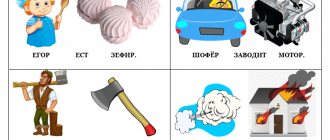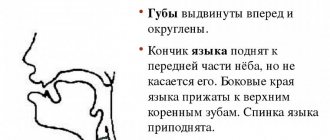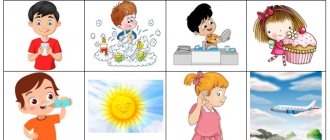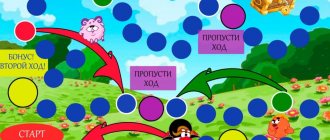Lesson 3
Exercise to develop a long exhalation: Close your wide tongue on your upper lip, bring a strip of paper (just above your nose). Blow on a paper plume (the air stream should go obliquely upward). "The plane is buzzing." Pronunciation of the sound [u] with changes in the pitch and strength of the voice. Exercise for lips Alternating exercises “Smile” and “Pipe”. Exercises for the tongue “The tongue swings on a swing.” Open your mouth wide, raise your wide tongue to your nose, then lower it to your chin. “Let’s hide our teeth.” Cover the upper teeth with a wide tongue, then the lower ones. “Glue on some candy.” Place a piece of candy on the edge of your tongue sticking out of your mouth. Suggest sticking it to the roof of your mouth behind your upper teeth. Development of switchability of the organs of the articulatory apparatus and development of coordinated work of the lips and tongue “Playing the drum.” Pronouncing syllable combinations ta-da, ta-da, ta-da, ta-da, you-dy, you-dy, you-dy with the movement of the index fingers of both hands. Development of phonemic awareness Definition of the sound [w] in words. Find toys that have the sound [sh] in their names. (Matryoshka, rattle, Cheburashka, bear, machine, ball.) Determining the position of the sound [w] in the words ball, bear, baby.
Sound automation exercises [Ш]. Card 1
Date of:___________
1. Perform articulation gymnastics.
2. Pronounce the sound [Ш] for a long time.
3. Pronounce the syllables, clearly pronouncing the sound [Ш].
sha-shi-she sha-shi-shi sha-she-she shi-she-sha she-shi-shi she-sha-sha she-sha-shi shi-sha-sha shi-she-she
4. Pronounce words, clearly pronouncing the sound [Ш]. (In case of incorrect pronunciation of the sounds [R] and [L], do not pronounce the underlined words)
Step, ball, scarf, puck, mine, hat, little mice, earflaps, decide, interfere, breathe, horse, noodles, chess.
Yours, ours, porridge, Dasha, Masha, Lyosha, Pasha, Misha, Natasha, Andryusha.
Tire, awl, sew, breathe, write, reeds, kids, bruise, mistake, car, jug, sewed, decided.
Overcoat, hiss, wide, rose hips, ears, mice, galoshes, lilies of the valley, pea, junior, silence.
Neck, pole, six, wool, target, collar, decision.
Rustle, bag, fluff, top, pot, cockerel, strap, big, mouse, walked, silk, whisper, left, found, came, entered.
Screw, joke.
Seamstress, seams, wardrobe, box, school, schoolboy, skin, slag, helmet, boat, hat, bumblebee, schnitzel, lace, sleepers, spy, headquarters, darn, curtain, thing, steering wheel, bayonet,
5. Pronounce syllables and words, clearly pronouncing the sound [Ш].
sha-sha-sha - step sha-sha-sha - porridge shi-shi-shi - sew shi-shi-shi - mice sho-sho-sho - seam sho-sho-sho - whisper shu-shu-shu - noise shu -shu-shu - I'll bite
6. Pronounce sentences, clearly pronouncing the sound [Ш].
Masha has lilies of the valley. The reeds are noisy. The mouse has little mice. Ilyusha kicks the puck. Alyosha hurt his leg. Pasha and Timosha have cars. They bought Alyosha a large earflap hat. Masha is carrying a jug. Dasha has a silk shawl. Misha is rolling the car.
Lesson 6
Exercise for developing a long exhalation “The wind is noisy.” Place the bottle upside down at nose level. Raise your wide tongue to your upper lip and blow strongly on your tongue. Noise is heard in the bubble. "The baby elephant drinks some water." Make a “proboscis”. Inhale and exhale air through your mouth. Lip exercises Repetition of exercises from previous classes. Development of coordinated movements of the lips and tongue. Extend the lips into a “tube” and the tongue into a “cup” (outside the mouth). Exercises for the tongue Repetition of exercises from previous lessons. "Harmonic". Smile, open your mouth slightly. Glue your tongue to the roof of your mouth, then, without lowering your tongue, close and open your mouth. As you repeat the exercise, open your mouth wider and hold your tongue longer. Development of switchability of the organs of the articulatory apparatus and development of coordinated work of the lips and tongue. Hippo Booby learns to pronounce the syllables bdi-bdi-bdi, bdi-bde, bdya-bde, bde-bdya-bdi. Development of phonemic perception Selecting pictures whose names contain the sound [w] from other pictures whose names contain [s] and [z]. The teacher pronounces the words, and the child chooses pictures whose names contain the sound [w]. Producing the sound [sh] The position of the organs of the articulatory apparatus when pronouncing the sound correctly [sh] The lips are slightly rounded and stretched forward in a “tube”. The teeth are brought together at a distance of 1-2 mm. The tip of the tongue is raised in a “cup”, but does not touch the palate. The lateral edges of the tongue are pressed against the upper molars, and the middle of the front of the tongue forms a semilunar fissure with the palate just behind the alveoli. The soft palate is raised, the vocal cords are open. The exhaled air stream is strong. If you put the back of your hand to your mouth, you feel warmth. Techniques for producing sound [w] Auditory perception of sound. Creating an auditory image of the sound “Noisemakers”. Onomatopoeia The sound of the wind in the forest; the rustle of leaves on the trees; rustling of dry leaves; rustling of dry hay or straw, paper; the hiss of a gander, a snake; the rustling of mice in a hole, tires on the pavement; the sound of air escaping from a punctured balloon, a locomotive releasing steam. Formation of a visual image of the sound [w] Showing the articulatory profile. Clarification of the position of the lips, teeth and tongue. Description of the position of the organs of articulation. Forming a sense of the position of the organs of articulation with the help of toys. Look how the monkey lifts its tongue “cupped” by its upper teeth. Demonstration of correct articulation of the sound [sh]. Draw the child's attention to the position of the lips, teeth and tongue. Plastic representation of the shape of the tongue with the hands. With your right hand, depict the shape of the tongue as a “cup”, and with your left hand, the palate. Setting the sound [w] according to R.I. Levina (1965) Setting the sound [w] by imitation Raise the tongue to the upper lip and exhale air evenly, forcefully, controlling the air stream with the back of the hand. Having achieved the release of a warm stream of air from the position of the tongue at the upper lip, move the tongue over the upper teeth to the palate with the mouth open. Round your lips and stretch them forward, bring your teeth together at a distance of 1-2 mm and exhale. The sound should be [w]. Setting the sound [w] based on the sound [t] Pronounce the sound [t] several times at intervals of 2-3 seconds. Then the setting is given: the tongue “knocks” not on the teeth, but on the tubercles (alveoli). The sound [t] is pronounced at first with an aspiration, while a weak and short hissing sound is mixed with the sound of the explosion. Round your lips and extend them forward, raise your tongue to the front of the palate. Press the lateral edges of the tongue against the molars. Transition from the sound [t] to the sound [w]: t-t-tshshsh. Subsequently, the noise lengthens and is freed from the previous sound [t]. Setting the sound [w] on the basis of the sound [r] Pronounce the drawn-out sound [r] without a voice or in a whisper, gradually reducing the force of exhalation until the vibration stops and a faint hiss appears. With repeated exercises, the sound [w] is obtained without the previous pronunciation of a dull sound [r]. Hissing can be obtained by touching the lower surface of the tongue with a spatula, slowing down the vibration of the tongue. Setting the sound [w] on the basis of the sound [s] Place the tongue behind the lower teeth. Invite the child to pronounce the sound [s]. At the same time, use a spatula or probe to lift the tongue upward. Using the fingers of your right hand, lightly press on your cheeks and push your lips forward. Instead of a whistle, you should get a hiss. You can invite the child to repeat the syllables sa, so, sy, asa, asy, as, os while simultaneously lifting the tongue with a probe or spatula. Setting the sound [w] on the basis of the sound [h] Pronounce the sound [h] followed by a long exhalation. You should feel a warm stream of air on your hand brought to your mouth.
Lesson 1
Spatial orientation Cross orientation. - Place your right hand on your left shoulder. Place your left hand on your right knee. Touch your left ear with your right hand. With your left hand touch your right cheek. “We go up the mountain, we go down the mountain.” Pronunciation of syllables in combination with movements of the index finger. Exercise for developing a long exhalation “Let's warm up our hands.” Take a deep breath through your nose. Round your lips and exhale forcefully through your mouth. A warm air stream should be felt. Repeat 3-4 times. Lip exercise “Surprise”. Round your lips and pull them forward. Make the sound [o]. Exercises for the tongue “The tongue looks for a crack in the fence.” Insert a wide tongue into the gap between the teeth. "Spatula". Smile, open your mouth slightly, place the wide front edge of your tongue on your lower lip. Hold in this position for a count of up to 10. Coordination of breathing, articulation and phonation Game tasks “The boat rocks on the waves.” Drawing wavy lines in a box of millet cereals. Development of phonemic perception Isolating the sound [w] from a number of sounds that are distant in terms of acoustic and articulatory characteristics. Sounds: [v], [w], [l], [sh], [p], [b], [f], [sh], [m], [n], [sh]. Syllables: la, sha, fu, wu, po, ko, by, gy. The words hat, lump, fur coat, jar, shirt, raspberry.
Lesson 4
Exercise for developing a long exhalation “Focus”. Place a piece of cotton wool on the tip of your nose. Smile, open your mouth slightly. Place the wide front edge of the tongue on the upper lip so that its side edges are pressed and there is a “groove” in the middle. Blow off the cotton. The air should flow through the middle of the tongue, then the cotton wool will fly upward. Lip exercise “Elephant trunk”. Round your lips and pull them forward. Hold your lips in this position for a count of up to 6. Exercises for the tongue “Swing”. Raise and lower your wide tongue behind your teeth, touching it with the tip of the upper gum, then the lower gum. Place the tip of your tongue under your upper lip, then tear it off with a click. "Cup". - Prepare a “cup”, I will treat you with juice. What juice will you drink? — Open your mouth slightly, place your wide tongue on your lower lip, then lift the tip and lateral edges of the tongue upward; a depression should form in the middle part of the tongue. Development of the voice, switchability of the organs of the articulatory apparatus and the development of coordinated work of the lips and tongue “Conversation of the Naf-Naf and Nuf-Nuf piglets.” Pronouncing the syllables na-na-na, ny-ny-ny, well-well-well, but-but-but with a change in stress and intonation (fearful, confident, angry, calm). Development of phonemic perception Find pictures on the topic “Clothing”, the names of which contain the sound [w]. Determining the position of the sound [sh] in the words hat, scarf, shirt, pants, shower. Arrange the pictures on the typesetting canvas. Place objects in the names of which the sound is heard at the beginning of the word on the top strip, on the middle - those whose names have the sound in the middle, on the bottom - those whose names have the sound at the end.
Lesson 5
Exercise for developing a long exhalation “A strong wind blows leaves.” Place a wide tongue (“spade-toy”) on the lower lip. Blowing with the formation of a “groove” along the midline. Lip exercise “The trunk of a big elephant and a small elephant.” Alternating wide and narrow “tubes”. Exercises for the tongue Repetition of exercises from previous lessons. "We're riding a horse." Clicking the tongue. The wide tip of the tongue is sucked to the palate and comes off with a click. "Rose petal". The tongue is cupped on the outside, then inside the mouth. Make sure that the lateral edges of the tongue are pressed against the upper molars. Development of switchability of the organs of the articulatory apparatus and development of coordinated work of the lips and tongue “Conversation of Hippos.” Pronouncing syllable combinations bda-bda, bdo-bdo, bdu-bdu, bdy-bdy; bda-bdo-bdy, bda-bda-bdu-bdy with a change in intonation. Development of phonemic perception Determination of the position of the sound [sh] in the words Shura, Masha, Natasha, kre-pysh, shorty, silly, naked.
Sound automation exercises [Ш]. Card 2
Date of:___________
1. Perform articulation gymnastics.
2. Pronounce the sound [Ш] for a long time.
3. Pronounce the syllables, clearly pronouncing the sound [Ш].
sha sha - shu sha - sho - shu sho shi - sho shi - shu - she shu she - sha sho - sha - shi sho - she she - shi - sha she shu - shi shu - she - sho
4. Pronounce words, clearly pronouncing the sound [Ш].
shawl tire noise seam hat awl jester silk washer neck fur coat shock chess boss joke whisper
shampoo thorns joker jackal overcoat skimmer naughty rosehip champignon shaman sewing
5. Game "One-many"
Tire-tire step-steps
hat-...overcoat-...puck-...shaman-...neck-...shampoo-...joke-...
6. Pronounce sentences, clearly pronouncing the sound [Ш].
The mine is noisy. Mom has a silk shawl. The jester makes up jokes. Mom will sew a fur coat. The boss doesn't like noise or jokes. There are thorns on the rosehip. The naughty ones were making noise and playing pranks. Someone hisses over the rosehip. It is convenient to remove the champignons with a slotted spoon.
What you need to know about sound automation?
The peculiarities of speech development are such that the child first begins to pronounce an isolated sound. Correct pronunciation of words and sentences is more difficult for children and requires some effort. For example, you can often encounter a situation where a baby hisses “Shhh” clearly and clearly, but instead of “hat” he continues to say “sapka”. Or, in a calm state, he pronounces words correctly, but when he is emotionally excited, he begins to “swallow” or replace sounds. This means that conditioned reflex connections in the cerebral cortex are not fully formed. To complete the process and bring correct pronunciation to automaticity, training is needed.
Automation of hissing sounds is carried out in stages in a certain sequence. First, the [w] is staged, the details of which can be found here. After the child pronounces a separate sound correctly, it is practiced:
- in syllables;
- in words;
- in sentences;
- in verse;
- in stories;
- in independent speech.
It is important to follow this sequence. You cannot move to the next difficulty level if the sound on the previous one has not yet been mastered. The child will make mistakes, and this can lead to the formation of incorrect conditioned reflex connections.








